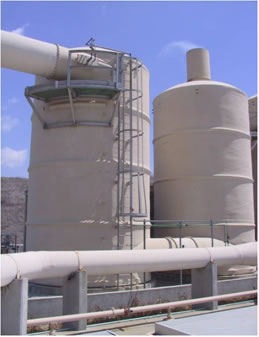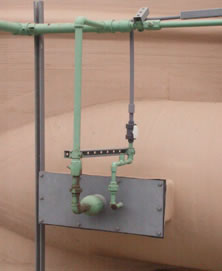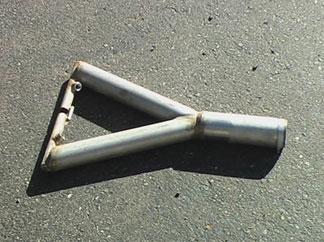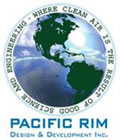CITY OF OCEANSIDE - CAPacific Rim and AEC (Automated Environmental Controls) designed the first workable automated control system for mist scrubbing technology, eliminating erratic sodium hypochlorite addition problems that plagued this valuable technology. The City of Oceanside saved over $100,000 per year in chemical costs when we retrofitted this system. |
||||
PROBLEM:There are many reliable odor/toxic compound abatement technologies. Each has it strength and limitations. There is no process can "do it all". One of these technologies, the use of low micron mean diameter aqueous mist (mist scrubbing), is ideal for scrubbing where high particulate loading is entrained in the air steam. Its principal disadvantage (until Pacific Rim and AEC came around) was a lack of an effective automated control system. The original mist equipment was unable to automate the addition of sodium hypochlorite which caused the scrubbers to constantly over or under feed the chemical. The City of Oceanside's San Luis Rey wastewater treatment plant recognized this problem. Mist scrubbers of the original design (with defective automated control) were treating foul air from the head works and load equalization tank areas. The foul air from these areas has dramatic fluctuations in the odorous compound concentrations. Out of necessity the plant set the manual sodium hypochlorite pumps at the rate required to handle the highest odor loading but this meant that most of the time excess chemicals were spewing out the stack. This excess sodium hypochlorite (bleach) was both expensive and the cause of damage to surrounding equipment/personnel at the plant. SOLUTION:The City of Oceanside wanted to reduce the health risk and cost of wasted chemicals associated with operating the mist scrubbers. They hired Pacific Rim and AEC to develop a workable automated control for the mist scrubbers. The solution came easy when the firms abandoned the conventional approach and addressed the problem form an entirely different perspective - thinking outside the box. Pacific Rim studied the chemical stoichiometry relevant to the process and determined a whole new sensor approach had real promise. AEC developed sophisticated new process control logic that included PID loops with algorithms that incorporate the relevant chemical reaction relationships between measurable process variables. This programming also included automated adjustments for ancillary variables like temperature and pH. This initial approach turned out to be correct. After fine tuning, the first reliable automated control system for mist scrubbing was created. The City of Oceanside saved over $100,000 per year in chemical costs when we retrofitted the existing head works and holding tank mist scrubbers with our control system. Our proprietary control logic and specialized sensors eliminated the over and under dosing of sodium hypochlorite. |

This photo shows the two mist chambers for this scrubber. The foul air enters the left chamber at the top, is immediately mixed with chemically laden mist, and then spirals down the cylinder exiting at the transition duct between cylinders at the bottom. The second stage reverses the process. The partially clean air enters at the bottom, is mixed with more mist and then spirals up. Near the top, the treated air passes through a demister and then out the stack. The opaque color leaving the stack is normal for a mist scrubber. It is clean air with fine water droplets that were not removed as the air passed through the demister.

This is a detail of the nozzle location in the transitional duct. (This photo was taken of a different scrubber than the one shown in the photo above, so it does not align with the nozzle assemblies shown in that image.)

This is a photo of the nozzle attached to the back side of the plate (inserted into the duct) shown in the previous photo. The mist is made when two diametrically opposed jets of air and water collide directly in the middle of the opening seen at the left side of the triangular shaped portion of this nozzle. (Contact our technical support team for additional details on this process.)
|
|||
| All Text ©Copyright 2008 Pacific Rim Design & Development, Inc. | ||||
